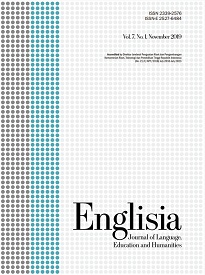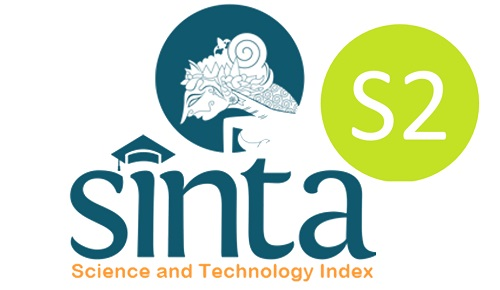Toponymy and its aspects in naming villages as tourism destinations in Madura: An ethnolinguistics perspective
DOI:
https://doi.org/10.22373/ej.v11i2.20200Keywords:
Toponymy, Madura, Tourism, EthnolinguisticsAbstract
This study is intended to analyze the category of toponyms of tourism destinations in Bangkalan, Madura in particular the four villages where the tourism destinations exist based on the aspect of the naming system. Then, it identifies the relation between the toponym with the cultural values of the names of those tourism destinations. This study used a descriptive qualitative method. The data are names of the villages in Kamal, Socah, and Bangkalan districts in which there are four tourism villages. The data collection was carried out by observing, interviewing the head of the villages, and reviewing the document of villages for tourism destinations. Results of the study show that there are three aspects of toponymy in the four tourism villages. They are toponymy of vegetation, history, and embodiment. There is no regional toponymy. From the aspect of naming the villages, it can provide important cultural and historical moments representing the people's lives, religious, and linguistic creativity. The place name is not merely arbitrary but depends on various factors or aspects and provides linguistic and cultural information toward the name of the four tourism villages in this study.
Downloads
References
Alwi, Hasan. (2005). Kamus Besar Bahasa Indonesia ke-3. Balai Pustaka. Jakarta .
Anshari, B.I, Dede, M., Tirtayasa, R., Musthafa, K.T., (2017) Kajian etnosemantik dalam toponimi wilayah kabupaten dan kota Cirebon. Prosiding Seminar Internasional Leksikologi dan Leksikografi. “Teknologi Bahasa dan Budaya dalam Penelitian Leksikologi dan Leksikografi”
Buza, Mircea. (2011). On the Origins and Historical Evolution of Toponymy on the Territory of Romania.Rev. Roum. Géogr./Rom. Journ. Geogr.,55, (1), p. 23–36.
Diana, Ari. (2022). Onomastika dalam cerita rakyat daerah Jambi berjudul Sebakul. Pelitra. Jurnal Pendidikan Bahasa dan Sastra Indonesia, 5(1), 46-57
Djindan, Nabillah & Lauder, Multamia RMT. (2021). Penelusuran toponimi pegunungan di kawasan taman nasional Bromo Tengger Semeru. Jurnal Pesona, 7 (1). 14-24
Duranti, A. (1997). Linguistic Anthropology. New York: Cambridge University Press.
Forde, C.D. (1963). Habitat, Economy, and Society. New Yok: Button.
Halayqa, I.K.H. (2000). Natural and Cultural Factors Influenced the Toponyms of Al-Shuyoukh Town in Hebron District.
Hidayah, Nurul. (2019). Toponimi Nama Pantai di Yogyakarta.Prosiding Seminar Nasional Linguistik dan Sastra (SEMANTIKS).“Kajian Linguistik pada Karya Sastra” https://jurnal.uns.ac.id/prosidingsemantiks
Humaidi, A., Safutri, Y., Djawab, AA. (2021). Bentuk satuan kebahasaan dan makna toponimi nama desa di wilayah Kabupaten Tabalong. Jurnal Basataka (JBT), 4 (1)
Jayanti, Arum. (2021). Toponimi nama-nama kampong di Kotagede.BATRA, 7 (1)
Komara , Ujang, Cece Sobarna, Gugun Gunardi, Ahman Sya. (2019). A Linguistic Study of Toponymy and Environmental Identity in Sundanese Ethnic. International Journal of Innovation,Creativity and Change.8 (3), 398-412
Kramsch, C. (2001). Language and Culture. New York: Oxford University Press.
Lance, Donald M. (2001) .Toponymy in Missouri, Names, 49:4, 228-230
Medway, Dominic and Warnaby, Gary. (2014). What’s in a name? Place branding and toponymic commodification. Environment and Planning 46, 153 – 167
Munir, Mesiyarti. 2017. Jejak Indonesia dalam Penamaan Nama Tempat dan Jalan di Singapura: Sebuah Kajian Toponimi. https://linguistik.fib.ui.ac.id/. 183 --185
Oktovianny, Linny. (2020). Toponimi Talang di Palembang: kajian Etnolinguistik. Konferensi Linguistik Tahunan Atma Jaya. 252-254
Parker, Jonathan. (2012). Toponymy & Environmental Identity. Comparative culture, the journal of Miyazaki International. 17, 64-84
Pateda, Mansoer.(2001).Semantik Leksikal. Jakarta: Rineka Cipta.
Perono Cacciafoco, Francesco., Binte Adzman, Nurlena., Bte Shari, Nur Shahirah. (2020). Mythical Place Names: Naming Process and Oral Tradition in Indonesian Toponymy. RHGT. Review of Historical Geography and Toponomastics. XII (23-24), 25-35
Prasetyo, Yudi & Amin, AF. (2017). Pendekatan toponimi dalam penelusuran sejarah lokal nama Kecamatan Sidoarjo. Jurnal Edukasi, 3(2)
Rais, J., et al. (2008). Toponimi Indonesia. Jakarta: Pradnya Rosdakarya.
Resticka, Gita A. & Marahayu, Nila Mega.(2019). Optimalisasi toponimi kecamatan di Kabupaten banyumas guna penguatan identitas budaya masyarakat Banyumas.Prosiding Seminar Nasional dan Call for Papers. ”Pengembangan Sumber Daya Perdesaan dan Kearifan Lokal Berkelanjutan IX” 19-20 November 2019
Robiansyah, Ahmad. (2017). Toponimi Pasar Tradisional di Kota Yogyakarta. Fakultas Ilmu Budaya, Universitas GadjahMada. Yogyakarta.
Rustinar, Eli & Kusmiarti, R. (2021).Struktur Bahasa pada Toponimi Jalan di Kota Bengkulu.Jurnal Onoma: Pendidikan, Bahasa dan Sastra .7 (1). 167-181
Sibarani, Robert. (2004). Antropolinguistik: Antropologi Linguistik atau Linguitik Antropologi. Medan: Penerbit Poda.
Sobarna, Cece., Gunardi, Gugun., and Wahya. (2018).Toponimi Nama Tempat Berbahasa Sunda di Kabupaten Banyuma. Panggung. 28 (2), 147-160
Sudaryat, Y. (2009). Toponimi Jawa Barat (Berdasarkan Cerita Rakyat). Bandung: Disbudar Jawa Barat.
Sugianto, Alip. (2017). Etnolinguistik, Teori dan Praktek. Ponorogo: Nata karya.
Downloads
Published
Issue
Section
License
Proposed Policy for Journals That Offer Open Access
Authors who publish with Englisia journal agree to the following terms:
- Authors retain copyright and grant the journal right of first publication with the work simultaneously licensed under a Creative Commons Attribution License that allows others to share the work with an acknowledgement of the work's authorship and initial publication in this journal.
- Authors are able to enter into separate, additional contractual arrangements for the non-exclusive distribution of the journal's published version of the work (e.g., post it to an institutional repository or publish it in a book), with an acknowledgement of its initial publication in this journal.
- Authors are permitted and encouraged to post their work online (e.g., in institutional repositories or on their website) prior to and during the submission process, as it can lead to productive exchanges, as well as earlier and greater citation of published work (See The Effect of Open Access).









